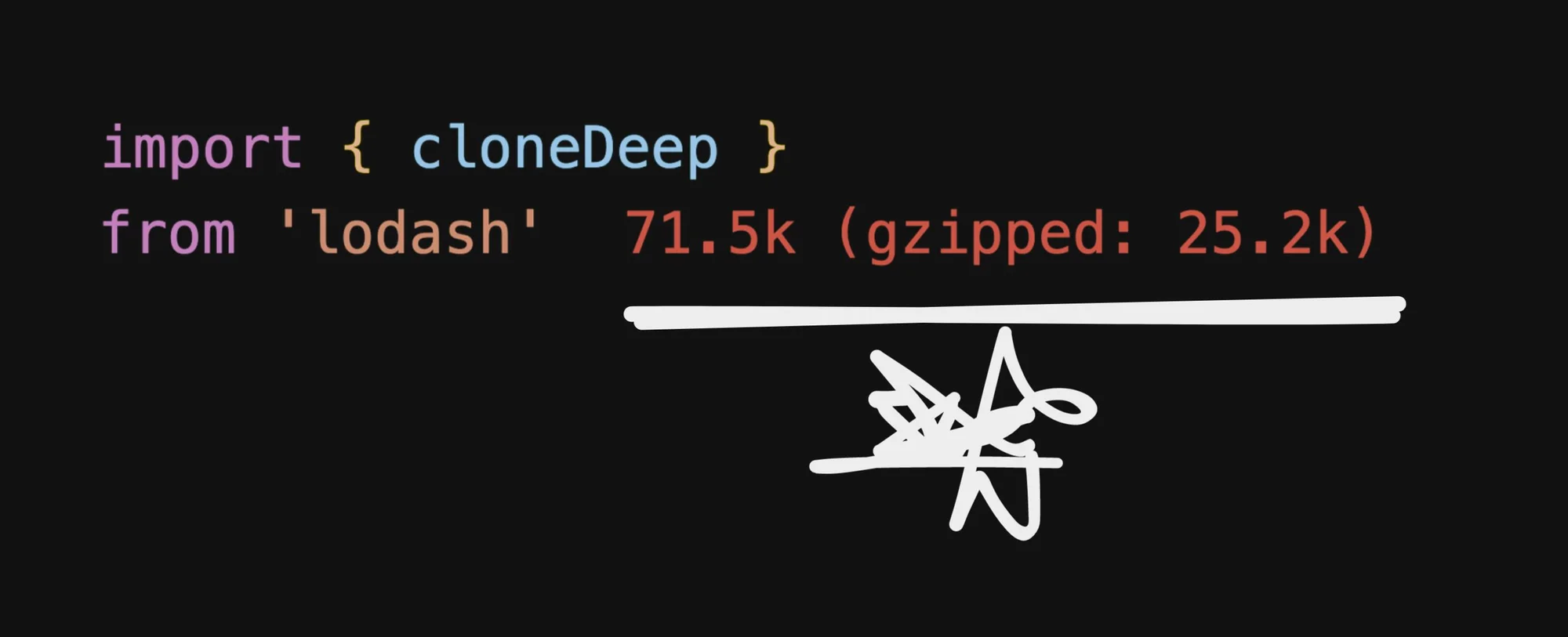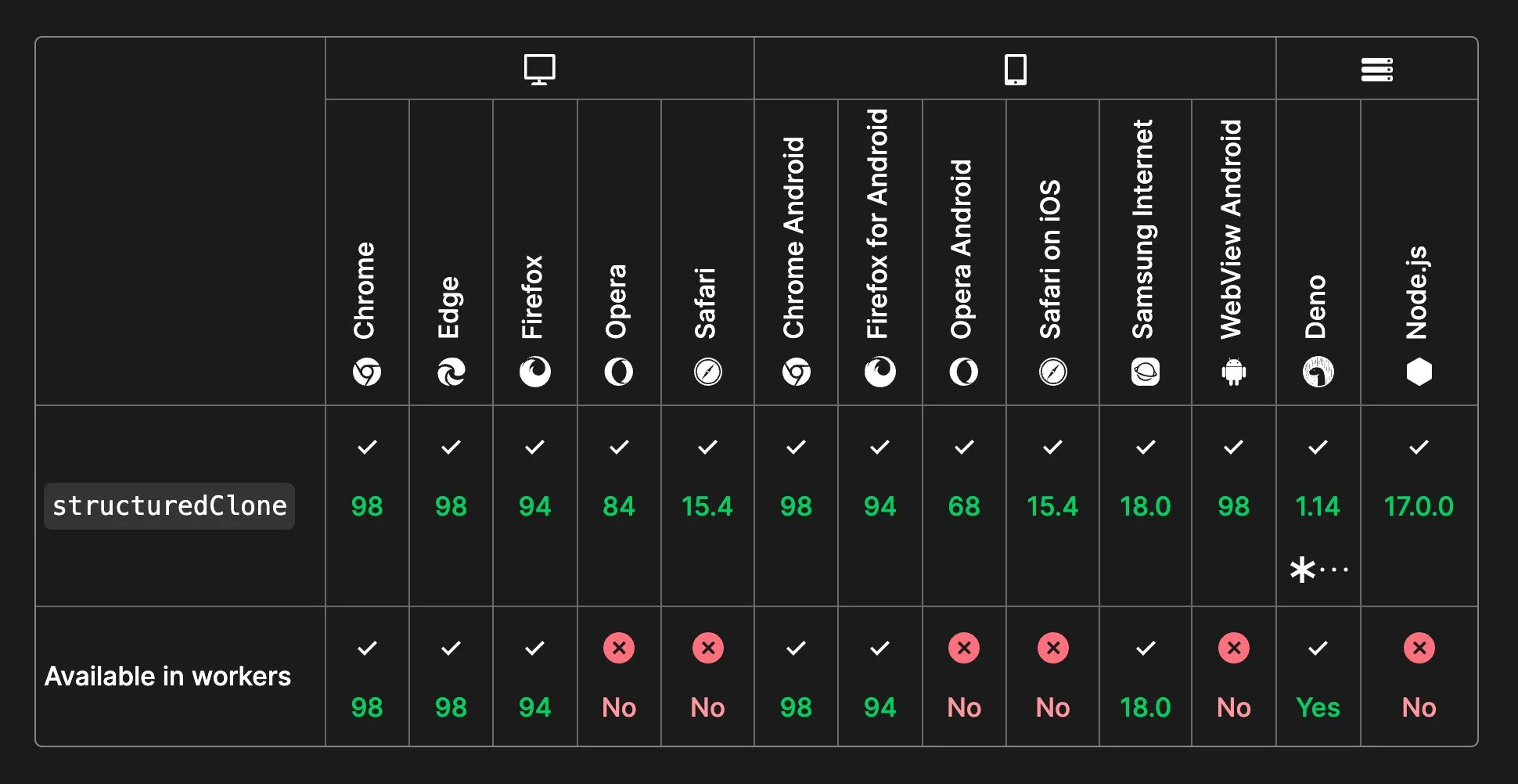译:现代化JavaScript深拷贝方式
你知道现在 JavaScript 有一种原生的深拷贝方法吗?
没错,就是 structuredClone 方法。该方法已内置于 JavaScript 运行时中。(译者注:Nodejs > 17)
1 | |
你是否注意到在上面的例子中,我们拷贝整个对象同时也拷贝了内嵌的数组甚至是 Date 对象。
并且所有的一切都符合我们的预期。
1 | |
是的,structuredClone 除了实现上述功能外,还能实现下面功能:
- 支持拷贝无限嵌套的对象和数组
- 支持拷贝循环引用
- 支持拷贝多种 JavaScript 类型,如
Date,Set,Map,Error,RegExp,ArrayBuffer,Blob,File,ImageData等。 - 转移任何可转移对象(译者注:有点像 Rust 中所有权的转移。MDN 中的例子很不错。)
比如,像下面这种抽风的示例也会符合预期:(译者注:可以去控制台试试,真的无限嵌套了)
1 | |
为什么不展开对象呢?
需要注意的是我们正在讨论深拷贝。如果你仅仅只需要做浅拷贝,即不用拷贝那些嵌套的对象或者数组,那自然是可以使用对象展开的。
1 | |
又或者是下面两种方式
1 | |
但只要有嵌套对象,我们就会遇到问题:
1 | |
像上面的例子,我们并没有完全拷贝这个对象。
两个对象间仍然共享日期类型和数组的引用,如果我们想修改那些我们认为只是拷贝对象的属性时,就会引起严重的问题。(译者注:不久前还真在生产上遇到过这个问题。某个配置在一个方法内部被修改了,导致整个服务起不来。最终排查下来就是对象被污染造成的。)
为什么不用 JSON.parse(JSON.stringify(x))?
是的,这也是一个技巧。同时也是一个不错方法,并且性能上也让人惊讶,但仍存在一些缺点。而 structuredClone 可以解决这些缺点。
这里有一个例子:
1 | |
如果我们打印 problematicCopy 就能看到:
1 | |
这显然不是我们想要的!date 应该是一个 Date 对象而非字符串。
会出现这样的情况是因为 JSON.stringify 只能处理基本的对象、数组和基本数据类型。而其他数据类型的处理方式则各不相同。比如日期类型会被转为字符串,但 Set 类型则转换为 {}。
JSON.stringify 甚至还会忽略某些类型,比如 undefined 或者方法。
比如下面这个例子,我们用 JSON.stringify 来拷贝 kitchenSink 对象:
1 | |
我们会得到这样的结果:
1 | |
是的,我们还必须删除循环引用,因为当 JSON.stringify 遇到后就会抛出错误。
当我们的需求满足时,尽管这个方式很棒,但 structuredClone 不仅也能做到并且还能做的更多。
为什么不是 _.cloneDeep?
至今为止,Lodash 的 cloneDeep 方法已经是解决这个问题的通用方式。
并且实际也符合我们的需求:
1 | |
但有一点需要注意。根据我的 IDE 中 Import Cost插件显示,引用这一个方法就需要 17.4kb(压缩后为 5.3kb)。

这仅是引用这一个方法。如果你用更普通的方式引入,并没有意识到 Tree Shaking 不会总按照预期执行。那你将会因为这个方法额外引入 25kb。

当然这对任何人来说都不会是灭顶之灾。在我们的示例中没有必要,更不用说在已经内置了 structuredClone 的浏览器内。
什么 structuredClone 不能拷贝的
函数/方法不能被拷贝
会抛出 DataCloneError 错误。
1 | |
DOM 节点
同样会抛出 DataCloneError 错误。
1 | |
属性表述、setter 和 getter
类似的元数据(meta-data)不会被拷贝。
比如,当有 getter 时,会拷贝结果但不会拷贝函数本身(或者其他属性上的元数据):
1 | |
对象原型
原型链不会被遍历或者重复。因此,当你拷贝一个 MyClass 的实例,被拷贝的对象将不会被认为是该类的实例(但该类中所有合法的属性都会被拷贝)。
1 | |
支持的类型列表
简单地说,不在下面列表中的内容无法被拷贝。
JS 内置函数
Array, ArrayBuffer, Boolean, DataView, Date, Error 类型(下面列出), Map , Object , 基本数据类型, 除了 symbol (比如 number, string, null, undefined, boolean, BigInt), RegExp, Set, TypedArray
错误类型
Error, EvalError, RangeError, ReferenceError , SyntaxError, TypeError, URIError
Web/API 类型
AudioData, Blob, CryptoKey, DOMException, DOMMatrix, DOMMatrixReadOnly, DOMPoint, DomQuad, DomRect, File, FileList, FileSystemDirectoryHandle, FileSystemFileHandle, FileSystemHandle, ImageBitmap, ImageData, RTCCertificate, VideoFrame
浏览器和运行时支持情况
所有主流浏览器都支持 structuredClone ,还包括了 Node.js 和 Deno。
需要注意的是 Web Worker 有更多的限制。

来源: MDN
结论
虽然经历了长时间的等待,我们终于可以通过 structuredClone 让深拷贝在 JavaScript 中像呼吸那样简单。谢谢你,Surma.